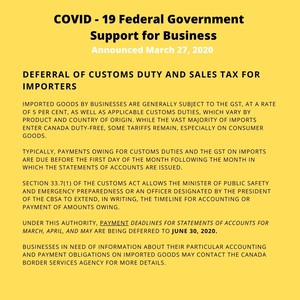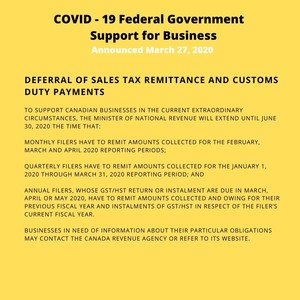COVID-19 Emergency Loans for Businesses
Updated May 19, 2020
Expanding CEBA
The program will now be available to a greater number of businesses that are sole proprietors receiving income directly from their businesses; businesses that rely on contractors; and family-owned corporations that pay employees through dividends rather than payroll.
To qualify under the expanded eligibility criteria, applicants with payroll lower than $20,000 would need:
- a business operating account at a participating financial institution
- a Canada Revenue Agency business number, and to have filed a 2018 or 2019 tax return
- eligible non-deferrable expenses between $40,000 and $1.5 million – eligible non-deferrable expenses could include costs such as rent, property taxes, utilities, and insurance
Expenses will be subject to verification and audit by the Government of Canada. Funding will be delivered in partnership with financial institutions.
More details, including the launch date for applications under the new criteria, will follow in the coming days.
Our government will continue to work on solutions to help business owners and entrepreneurs who operate through their personal bank account, as opposed to a business account, or have yet to file a tax return, such as newly created businesses.
For more information refer to the Prime Minister’s News Release here.
Updated April 16, 2020
The Government of Canada made $25 billion to businesses across the country affected by the COVID-19 pandemic through an umbrella Business Credit Availability Program (BCAP). As part of the BCAP suite of financial assistance programs for businesses now being rolled out by the Government of Canada, the following two main streams of emergency business loans to be opened in the coming week:
Canada Emergency Business Account (“CEBA”); and
Small & Medium Sized Enterprise (“SME”) Loan and Guarantee Program.
CANADA EMERGENCY BUSINESS ACCOUNT (CEBA) - UP TO $40,000 LINE OF CREDIT
Eligible businesses may borrow up to $40,000 through the CEBA mechanism. The CEBA is a federally funded revolving line of credit being made available to each eligible business which applies online. The CEBA online application portal(s) are expected to be operational this coming week. Expect publications from all the banks once the CEBA portal(s) open for applications.
Eligibility: CEBA funds will be available for business which paid an annual payroll of $20,000 to $1, 500,000 in 2019. More details to follow.
CEBA funds will be available for businesses which paid an annual payroll of $50,000 to $1,000,000 in 2019. At this time publicly available information suggests the intent of the funds is to cover non-deferrable costs such as payroll, rent, insurance, and utilities.
Revolving loan, then 5 year term loan: The CEBA will be a federally funded revolving line of credit until December 31, 2020. At the end of this calendar year it will be converted into a 5 year term loan, coming due at the end of 2025.
Interest Free Period, then 5% Interest: No interest will be payable in 2020, 2021, or 2022. Interest will begin to apply on any outstanding balance at an annual rate of 5%, payable monthly, starting January 1, 2023 for the remaining three year term until the end of 2025.
Repayment Deadline: The outstanding balance and applicable interest will mature and become payable in full at the end of 2025. No comment or concession has been made at this time regarding amounts unpaid at the end of 2025, so businesses should review the loan agreement terms carefully if they are concerned about this timeline, and assume commercial terms and rates at the time will apply.
25% Loan Forgiveness: Businesses who repay 75% of the outstanding balance on or prior to the end of 2022 will have the remaining 25% balance of their loan forgiven. This is the most advantageous aspect of the CEBA program. For each business which borrows on their CEBA line of credit this year, the Government will look at the amount outstanding on January 1, 2021, which is the calculation date for purposes of determining the amount of potential loan forgiveness. In order to qualify for 25% loan forgiveness, the business must repay 75% of the January 1, 2021 amount between then and December 31, 2022. The maximum amount which will be forgiven will be the greater of (i) $10,000 or (ii) 25% of the balance on January 1, 2021. To be clear, businesses which don’t borrow the full $40,000 will not have $10,000 forgiven, it will be a lower forgiveness amount equal to 25% of their January 1, 2021 total.
The repayment deadline for loan forgiveness eligibility is end of 2022. If 75% of the amount borrowed is not repaid before December 31, 2022, the business will not be eligible for any forgiveness according to the rules as we know them now. Details around forgiveness eligibility appear quite binary at this time; if 75% is not repaid prior to end of 2022 there appears to be no opportunity for forgiveness, meaning that the entire principal and interest amount will be required to be paid prior to end of 2025 and the opportunity for forgiveness missed.
Given the interest free period and the conversion from a revolving line to a non-revolving loan at the end of this year, we expect many businesses will plan to maximize the borrowed amount by December 31, 2020 and plan to wait to repay 75% as close as reasonably possible to December 31, 2022 and not earlier.
We recommend you continue to monitor details in this regard, which may change after this article is written. Business owners should review and be mindful of the exact terms at the time of applying and agreeing in case details change between now and then or are more nuanced.
Preparing to apply online: CEBA applications will only be available online. An officer or director of the company should plan to enroll and apply online. This must be a person able to make legal attestations for the business and authorized to bind the business. It may be prudent to ensure your directors and officers filings are up to date in case government officials cross-reference corporate profiles publicly available through the provincial Ministry. This person will be binding the company to the CEBA line of credit agreement. At a minimum, ensure the correct director(s) and officer(s) are authorized with your bank in advance.
The Government of Canada is advising that you will need your 2019 T4 Summary of Remuneration Paid statement at the time of application. Speak with your accountant or contact CRA if you require this to be re-issued.
Flow of Funds: The notional concept behind the CEBA is that the Government of Canada is providing federally guaranteed interest-free working capital loans to small businesses, but will release the funds through the banks. Your bank is well positioned to verify your business information and help guard against fraud. The Government of Canada is making CEBA funds available to the banks so that the banks can provide the businesses they know in each community with critical access to working capital during the crisis. Without the CEBA program, applying for new line of credit or loan facilities from the bank would have been time-consuming and futile for many businesses during this period of major revenue suspension.
By guaranteeing the loans and accelerating the application-to-approval timeline, the Government of Canada has fast-tracked the process and assumed default risk in the interest of allowing as many businesses as reasonably possible to receive CEBA funds. The federal guarantee of each of these new credit facilities is the critical element - something that has never been available to most private companies in Canada.
Once approved, the funds being made available to your business will be deployed through your business’s primary bank. If you have an account at more than one bank, you should determine your primary bank for purposes of CEBA right away. All banks are now recommending CEBA applicant clients have online banking arrangements in place and up to date.
SMALL & MEDIUM-SIZED ENTERPRISE (SME) LOAN & GUARANTEE PROGRAM - UP TO $6,250,000 LOAN PER SME
The Government of Canada has also announced the SME Loan & Guarantee Program being rolled out in the coming week, which will make larger loans available to businesses who need much more than $40,000 to survive. These are the business loan facilities which will be backstopped by EDC and BDC. More details of the sub-streams of this program are coming online daily through the Government of Canada, EDC, and BDC websites, as well as publications from the major banks referencing the SME Loan & Guarantee Program.
The SME Loan & Guarantee Program is designed to help larger SMEs maintain liquidity during this crisis period. If your business is interested in these programs, every indication at this time is that you should work through your primary bank, although information is also available through your BDC and/or EDC representatives if you are currently working with EDC or BDC or for new potential clients of BDC. If proceeding through your primary bank, your bank will field initial information back and forth and will contact BDC and/or EDC to coordinate eligibility and amounts. These facilities are premised on a return to revenue. They are interest-bearing, have longer potential repayment terms, and do not include an element of loan forgiveness (according to current rules). We are hearing from the local banks that they are also taking new clients for this purpose if you need a new primary bank to work through.
The SME Loan & Guarantee Program has two sub-steams as follows:
BDC Co-Lending Program. Through this sub-stream the Business Development Bank of Canada (BDC) will provide a guarantee to the business’s primary bank to co-lend a term loan to the business for operational cash flow requirements. BDC will assume 80% of the risk. The bank will assess, underwrite, approve, and fund the qualifying SME. The loan will be interest only for the first 12 months, with principal repayments starting after the first anniversary. After year one the loan will bear interest at a commercial rate. The loan will be subject to a 10 year repayment period. The amount made available will depend on cashflow requirements and revenue forecasts, up to a maximum of $6,250,000 per SME. Application details are evolving, so it is best to contact your primary bank, which will be the first stop to apply for these funds. BDC is administering this in tandem with the leading financial institutions, and is self-described as a shock-absorber for entrepreneurs during this cash crisis similar to the role it assumed during the 2008-2009 financial crisis and at times when drastic commodity price drops have put negative pressure on cash and supply chains.
EDC Guarantee: Through this sub-stream, Export Development Canada (EDC) will provide a guarantee to the business’s primary bank so that the bank can issue a new operating credit and cash flow term loan, up to a maximum of $6,250,000 per SME. The loan will be 80% guaranteed by EDC and must be repaid within one year. The SME must be Canadian based, the funding must be used to sustain operations, and must be net new funding. Application details are evolving, so it is best to contact your primary bank, which will be the first stop to apply for these funds. A company does not need to be a material exporter to qualify or work with EDC for this purpose during this current crisis. This funding sub-steam is available for domestic-oriented companies as well as exporters. This represents a temporary expanded role for EDC during the crisis, through enabling legislation, which now provides EDC with a broader mandate and scope to provide emergency liquidity for various sized Canadian companies.
OTHER PROGRAMS AND RELIEF
Commercial Rent Relief Program: The federal government is also working on a program to help businesses and commercial landlords cover their rents for at least three months, though the details still need to be worked out with the provinces and territories."This program will provide support to help small businesses with their rents for the months of April, May and June," Trudeau said. "To implement this program, we have to work with the provinces and territories as they govern rental relationships."
More details will follow as available.
Bank Payment Deferrals and Flexibility: Local bankers from the major financial institutions are reaching out to clients and working on customized credit relief or credit availability arrangements with many clients. Many are offering payment deferral arrangements, interest-only payment periods for business loans secured by a collateral mortgage, credit card payment deferrals, and reduced interest rates, each at the discretion of the bank and generally being assessed at the relationship manager level. For small businesses who may not have an assigned relationship manager, some deferral options are available through online banking buttons. All local banks and branches have indicated they are open for business and making key people available to assist existing and potential new clients navigate available facilities and options.
Canada Emergency Wage Subsidy (CEWS): More information is available here.
Farm Credit Canada: The Government of Canada has also funded Farm Credit Canada (FCC) an immediate additional $5 billion to facilitate fast-tracked relaxed lending to farmers, and other agribusinesses and food processors to cover cashflow deficiencies. FCC’s priority attention for such funds is ensuring producers are able to plant and meet other critical seasonal needs in light of the current amplified cash crisis for many. FCC is coordinating with the credit unions and banks for many agricultural and food industry clients with overlap. With respect to its direct facilities, FCC is offering existing loan principal and interest payment deferrals and access to additional two year credit lines up to $500,000, with a general security package, amount to be determined on a client by client basis. FCC is not directly offering interest-free loans or loan forgiveness at this time, but is offering a competitive interest rate on a new two year line of credit, with no fees to apply.
BDC: BDC led early efforts in making new and more flexible working capital loans of up to $2,000,000 available to businesses, even prior to announcement of the CEBA, and SME Loan & Guarantee Program announced last week by the Government of Canada. In addition to the SME Loan & Guarantee Program, BDC is lending working capital to eligible businesses, with an opportunity to postpone principal and interest payments on new facilities, and opportunities to postpone principal payments on existing facilities. Certain new facilities have reduced interest rates, and contain interest-only periods on term loans weighted for a balloon payment nearer the end, with application fees waived. Business and personal financial information is required and certain financial review and scrutiny will be required. We have details regarding the application process, criteria, and the security package requirements for business interesting in exploring this and being put in touch with BDC.
Tax & Duties Deferrals: The Government of Canada has also offered HST deferrals, customs duties deferrals, and income tax payment deferrals, you may discuss with your accountant.
















